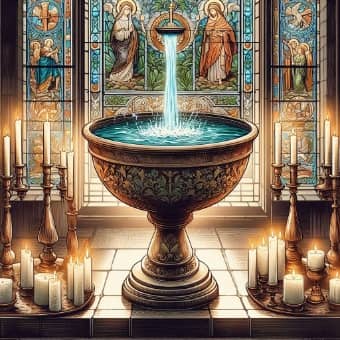Exploring the Deep Symbolism of Water in Catholic Rituals
Water, an essential element of life, holds profound symbolic meanings within the Catholic faith. This sacred element is integral to many rituals and ceremonies, from baptism to the blessing of homes. Below, we delve into the significance of water in various Catholic practices and how it embodies purity, life, and renewal.

This blog post contains affiliate links. When you click on a link on this page and make a purchase I may earn a small commission, at no additional cost to you. Thank you for your support.
Baptism
A Gateway to Faith
The most recognized use of water in Catholicism is in the sacrament of Baptism. This ritual symbolizes the cleansing of original sin, signifying the individual’s rebirth as a child of God. The water used during baptism represents purity and the purifying power of the Holy Spirit.
As stated in John 3:5, Jesus emphasized the necessity of being born of water and the Spirit to enter the Kingdom of God. This sacrament marks the beginning of a new life in the spirit of Christianity.
Holy Water
Protection and Purification
Holy water, usually found in fonts at the entry of a church or used in homes, is another key example of water’s symbolic use. Created by blessing water with salt, the Church imparts it with spiritual significance.
Catholics will often make the sign of the cross with holy water upon entering a church, reminding them of their baptism and providing spiritual protection. Holy water is also used during exorcisms and to bless individuals, objects, or places, thus warding off evil and purifying them from sin.
The Easter Vigil
Reaffirmation of Faith
During the Easter Vigil, the blessing of the baptismal water takes place, which is a highlight of the ceremony. This act reaffirms the community’s faith and recalls the baptisms of all present. It is a powerful reminder of the death, burial, and resurrection of Christ, themes intimately connected with the symbolism of water as life-giving and renewing.
The Asperges
Cleansing the Congregation
The Asperges, which is Latin for “you shall sprinkle,” is a ritual performed usually at the start of Mass during certain seasons such as Lent. The priest sprinkles holy water on the congregation, symbolically cleansing them as they prepare to celebrate the Eucharist.
This act highlights water’s cleansing properties and the ongoing process of purification and renewal within the faithful’s spiritual life.
Lustral Water in Liturgical Celebrations
During other liturgical celebrations, water is used to bless the congregation, showing its ongoing importance in rites of renewal and purification. For example, during the Palm Sunday procession, water is used to bless the palms.
Likewise, water is integral in the celebration of the Feast of the Epiphany, where homes are blessed with holy water.
You may also like our blog post article about Understanding The Liturgical Calendar – https://moodycatholic.com/understanding-the-liturgical-calendar/
Conclusion
In Catholicism, water is far more than a physical substance; it is a rich symbol of faith, protection, purification, and renewal. Each use of water in Catholic rituals is imbued with deep spiritual meaning, reinforcing the faith of believers and connecting them to the sacramental life of the Church.
By understanding these symbolic meanings, the devout can appreciate the profound impact of this sacred element in their practice of faith.
